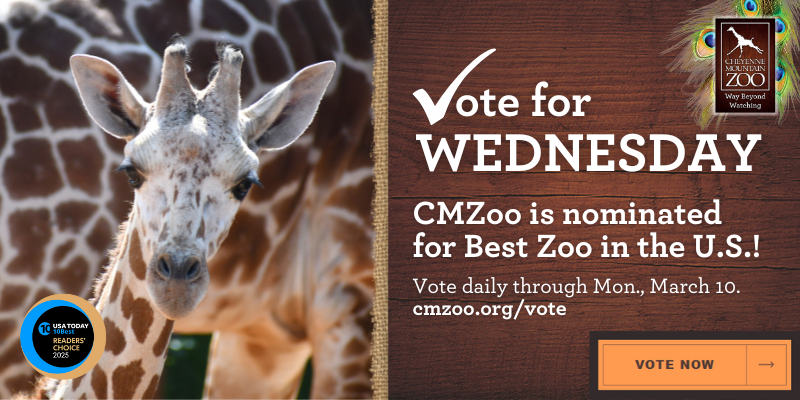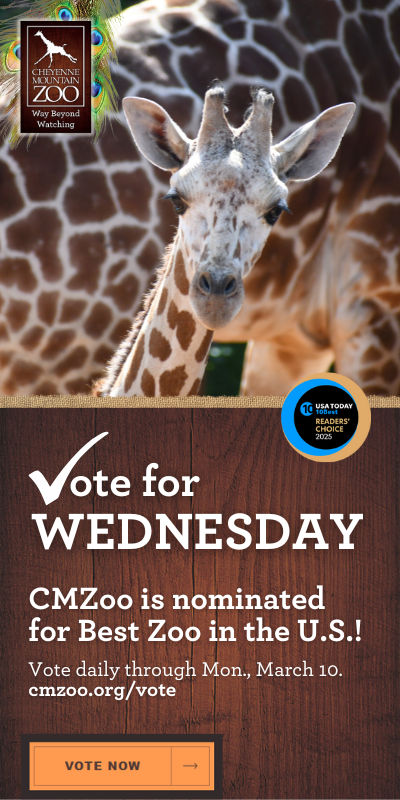Cheyenne Mountain Zoo will reopen to the public at noon today. Advance tickets are available for this afternoon at cmzoo.org/open.
Cheyenne Mountain Zoo is closed to the public today until at least noon due to a water main break. Refunds for advance ticket holders for 9 through 11:40 a.m. entry times will be processed automatically within a few business days; funds will be returned to their original form of payment as soon as the refund clears the banking system. Ticket holders do not need to contact the Zoo to request a refund.
A decision about whether the Zoo can open at noon will be made by 11 a.m. Please check the green bar at the top of cmzoo.org or our social media channels to see whether the Zoo will open. If the Zoo cannot open, refunds will be processed automatically, as described above.
At about 6 a.m. today, a water main break was discovered within the Zoo. Zoo staff quickly mobilized to address the break, which required water to be shut-off to the entire Zoo. Both ice on roadways and a lack of access to restrooms and water within the Zoo created conditions that required closure to the public for today.
Animal care staff was able to store enough water for our animals to get them comfortably through the shut-down.
The Zoo anticipates being able to reopen on Saturday at 9 a.m., if not sooner. Barring any additional announcements, ticket holders for Saturday and beyond should visit the Zoo at their ticketed time and date.
Further updates will be posted at the top of the page at cmzoo.org, and on our social media channels.
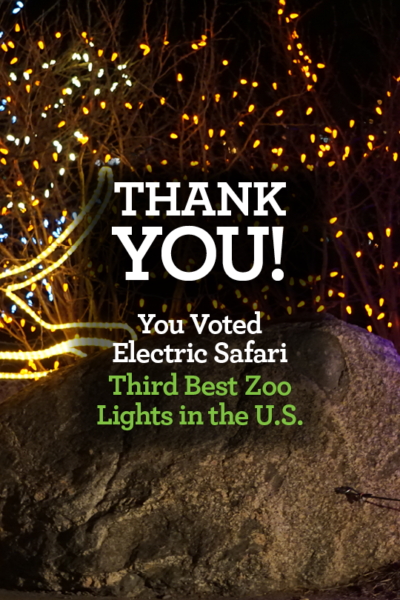

Annual holiday lights celebration continues through Friday, Jan. 1, 2021 – USA TODAY 10Best Readers’ Choice today announced that Cheyenne Mountain Zoo’s Electric Safari won third place in the national Best Zoo Lights category, for the second year in a row. This is the fifth year running that Electric Safari has ranked in the top ten.
The award-winning annual holiday lights celebration continues through Friday, Jan. 1 (except Christmas Eve, Thursday, Dec. 24), featuring 85 one-of-a-kind light sculptures, 50 acres of twinkling lights, and breathtaking nighttime views of Colorado Springs from Cheyenne Mountain.
Advance e-tickets are required for members and the general public, and they are going fast! Make plans to join us after Christmas, and reserve tickets now at cmzoo.org/electric.
El Paso County is at “Safer at Home – Severe Risk” or “Level Red” COVID-19 restrictions. The Zoo is operating under a revised Public Health Order from Colorado Public Health & Environment that allows us to open some buildings at limited capacity. The following changes will be seen at Electric Safari, while under Level Red precautions:
- Ticket capacity to the Zoo will remain limited, with advance timed tickets required.
– The outdoor areas of the Zoo will remain open, but some buildings will be closed. - The following buildings will be open at limited capacity:
– Giraffe barn
– Elephant/rhino barn
– Budgie Buddies
– Scutes Family Gallery
– The Loft
– Hippo and penguin buildings - Santa will be available for photos and to hear wishes as he travels around the Zoo during evenings through Wednesday, Dec. 23. Indoor visits and photo opportunities will not be available.
- Dining options will be limited, and available for take-out only. No indoor dining available.
- Thundergod Gift Shop will be open at 50% capacity, per current guidelines for retail establishments. Online ordering is also available at giftshop.cmzoo.org.
- Restrooms with direct outside access will be open. (see Electric Safari Program)
- Sky Ride will be operational, weather dependent. Only members of the same household are permitted per seat.
Electric Safari offers paid feeding opportunities with our famous giraffe herd and our budgie flock, and visits to the African lion exhibit, elephant and rhino barn, Rocky Mountain Wild (except grizzly bears), Asian Highlands, The Loft, Scutes Family Gallery and Australia Walkabout.
We’re grateful for our 2020 Electric Safari’s partners: Children’s Hospital Colorado, Colorado Springs Pediatric Dentistry, Cordera, US Bank, and your Colorado Springs Toyota dealers. For more information, visit cmzoo.org/electric.
About Cheyenne Mountain Zoo
Cheyenne Mountain Zoological Society was founded in 1926. Today, Cheyenne Mountain Zoo, America’s mountain Zoo, offers comprehensive education programs, exciting conservation efforts and truly fantastic animal experiences. In 2020, Cheyenne Mountain Zoo was voted #4 Best Zoo in North America and CMZoo’s Rocky Mountain Wild was named #2 Best Zoo Exhibit in North America by USA TODAY 10Best Readers’ Choice Awards. It is Cheyenne Mountain Zoo’s goal to help guests fall in love with animals and nature, and take action to protect them. Of the 233 zoos and aquariums accredited by the Association of Zoos and Aquariums (AZA), Cheyenne Mountain Zoo is one of just a few operating without tax support. Cheyenne Mountain Zoo depends on admissions, membership dues, special event attendance and donations for funding.


CMZoo’s 50 acres of twinkling mountainside lights, named 2019 Third Best Zoo Lights in U.S., is again nominated for national USA Today 10Best Readers’ Choice ranking. More than 50 acres of twinkling lights, 85 artisan-made light sculptures, breathtaking night time city views and the nearby sound of roaring lions can only mean one thing in Colorado Springs: Electric Safari is back.
Cheyenne Mountain Zoo’s 30th annual month-long celebration of the season will begin Friday, Dec. 4 through Sunday, Dec. 6, and continue Friday, Dec. 11 through Friday, Jan. 1, 2021, excluding Christmas Eve. Members and their accompanying paying guests are granted early admission at 4:20 p.m. General admission starts at 5:20 p.m. and the event ends at 8:30 p.m.
Electric Safari is free for CMZoo members, but advance e-tickets are required for all attendees. The general public and members can secure tickets at cmzoo.org/electric.
Attendees will enjoy lit trees, structures and sculptures, installed by the Cheyenne Mountain Zoo grounds and maintenance teams over three months of Electric Safari preparation. If all of those beautiful lights don’t un-Scrooge even the Grinchiest of holiday grumps, a cup of hot cocoa and a visit with Santa ought to do the trick. Kris Kringle will be travelling through the Zoo until Dec. 23 to hear holiday wishes and pose for free photos. The Mountaineer Sky Ride will be open (weather permitting) to provide incredible once-a-year views of the nighttime glow of Colorado Springs as a backdrop from the mountainside of twinkling lights.
All COVID-19 precautions will be in place for this event. Learn more at cmzoo.org/open. Outdoor areas of the Zoo will be open throughout the event, but most buildings will be closed due to Level Red COVID-19 restrictions. Dining options will be limited and available for take-out only.
The following animals will not be viewable, due to these closures:
– Giraffe
– Elephant/Rhino (viewing available through windows)
– Wallabies (viewing available through windows)
– Scutes Family Gallery
– The Loft
– Water’s Edge: Africa (limited access)
– Primate World
Electric Safari was named Third Best Zoo Lights in the nation last year, by USA Today’s 10Best Readers’ Choice Awards, and has once again been nominated. Supporters can vote once daily at www.cmzoo.org/vote through 10 a.m. MST on Monday, Dec. 7. Winners will be announced Friday, Dec. 18.
Electric Safari Fast Facts
Dates:
Friday, Dec. 4 – Sunday, Dec. 6, 2020
Friday, Dec. 11 – Friday, Jan. 1, 2021*
(*Electric Safari is not open on Christmas Eve, Dec. 24.)
Time:
5:20 – 8:30 p.m. nightly (last admission at 7:20 p.m.)
Early admission at 4:20 p.m. for Zoo members and their paying accompanying guests.
All guests, including those under age 2, and members must reserve an e-ticket in advance.
Electric Safari is sponsored by Children’s Hospital Colorado, Colorado Springs Pediatric Dentistry, Cordera, US Bank, and your Colorado Springs Toyota dealers. For more information, visit: cmzoo.org/electric.
About Cheyenne Mountain Zoo
Cheyenne Mountain Zoological Society was founded in 1926. Today, Cheyenne Mountain Zoo, America’s mountain Zoo, offers comprehensive education programs, exciting conservation efforts and truly fantastic animal experiences. In 2020, Cheyenne Mountain Zoo was voted #4 Best Zoo in North America and CMZoo’s Rocky Mountain Wild was named #2 Best Zoo Exhibit in North America by USA TODAY 10Best Readers’ Choice Awards. It is Cheyenne Mountain Zoo’s goal to help guests fall in love with animals and nature, and take action to protect them. Of the 233 zoos and aquariums accredited by the Association of Zoos and Aquariums (AZA), Cheyenne Mountain Zoo is one of just a few operating without tax support. Cheyenne Mountain Zoo depends on admissions, membership dues, special event attendance and donations for funding.


Rain, snow or shine, five remaining nights of Halloween festivities begin Friday, Oct. 23 – Cheyenne Mountain Zoo will feel the Halloween spirit when little ghouls and goblins attend Boo at the Zoo, resuming with its remaining five nights on Friday, Oct. 23, 2020. The event is a fun way for families to trick-or-treat and enjoy Halloween festivities in a unique environment. This year’s Boo at the Zoo started Oct. 17-18, and resumes on Oct. 23-25 and 30-31. Boo hours are 3:40 to 8:30 p.m. Advance e-tickets are required and available at cmzoo.org/boo. The Zoo will close for daytime admission on Boo nights at 3 p.m.
In addition to visiting select animal exhibits and trick-or-treating, frightfully fun attractions include a lighted pumpkin patch, a kid-friendly spooky haunted house, Ghoulish Graveyard and Pirates Cove. Attendees can also enjoy rides on the Mountaineer Sky Ride, weather permitting. The Sky Ride will be open as weather allows, providing a breathtaking view of Colorado Springs at night and a lift to two additional trick-or-treat stations at the top.
Boo at the Zoo will go on, rain, snow or shine. As an all-weather venue, refunds and exchanges will not be honored for weather-related reasons. Be sure to bundle up on cold nights and enjoy a Colorado evening on the mountain!
An elephant-sized amount of candy (4.5 tons) will be handed out at trick-or-treat stations throughout Boo at the Zoo. The Zoo’s candy supply is purchased from companies that are members of the Roundtable on Sustainable Palm Oil (RSPO), which is committed to the use of sustainable palm oil and the protection of orangutan habitats in the wild. To find your own Halloween candy that’s orangutan friendly, download CMZ’s sustainable palm oil shopping guide at cmzoo.org/palmoil.
COVID-19 spread prevention protocols are in place, including limited capacity throughout the Zoo, no off-site shuttle transportation, limited capacity in buildings, mask requirement for ages 11 and up in buildings, and more. Please visit cmzoo.org/open for a complete list of safety requirements and encouragements.
SELECT ANIMAL EXHIBITS ARE OPEN, INCLUDING:
– African Rift Valley giraffe building (be in line by 8 p.m.) In order to accommodate the maximum number of guests with our limited building capacity, your time in the giraffe building will be limited.
– African lions
– Australia Walkabout
– Encounter Africa elephant/rhino barn
– Goat Experience
– The Loft
– Scutes Family Gallery
– Water’s Edge: Africa
RESTAURANTS OPEN DURING BOO AT THE ZOO
– Grizzly Grill
– Pizza with a View
– Elson’s Place
– Cozy Goat (beverages only)
COSTUME REQUIREMENTS
For the safety of all guests, costume masks and costume weapons may not be worn by guests 12 years of age or older. Masks worn by guests 11 years of age and younger must have openings that allow the eyes to be seen and that do not obstruct peripheral vision. Balloons are not allowed inside the Zoo (even as part of a costume) for the safety of our animals and wild animals.
TRICK-OR-TREAT BAGS
Support the Zoo’s efforts to reduce waste by bringing your own trick-or-treat bags!
VOLUNTEERS NEEDED
Volunteers are crucial to the success and safety of Boo at the Zoo.
Positions include handing out or delivering candy, directing traffic and working the haunted house.
All volunteers must be at least 13 years old.
Volunteers ages 13-17 must be accompanied by a parent, guardian or school advisor at all times.
We will not assign specific positions until the evening of the event.
Curious about volunteering for Boo at the Zoo? Visit cmzoo.org/boo
FAST FACTS
Boo at the Zoo at Cheyenne Mountain Zoo
Remaining Dates: Oct. 23-25 and 30-31, 2020
3:40 to 8:30 p.m.
Advance e-tickets are required
www.cmzoo.org/boo
Boo at the Zoo is possible thanks to our generous sponsors, Children’s Hospital Colorado, Les Schwab Tire Centers, Raising Cane’s Chicken Fingers, T. Rowe Price and your Colorado Springs Toyota dealers, Larry H. Miller Toyota Colorado Springs and Larry H. Miller Liberty Toyota Colorado Springs.
About Cheyenne Mountain Zoo
Cheyenne Mountain Zoological Society was founded in 1926. Today, Cheyenne Mountain Zoo, America’s mountain Zoo, offers comprehensive education programs, exciting conservation efforts and truly fantastic animal experiences. In 2020, Cheyenne Mountain Zoo was voted #4 Best Zoo in North America and CMZoo’s Rocky Mountain Wild was named #2 Best Zoo Exhibit in North America by USA TODAY 10Best Readers’ Choice Awards. It is Cheyenne Mountain Zoo’s goal to help guests fall in love with animals and nature, and take action to protect them. Of the 233 zoos and aquariums accredited by the Association of Zoos and Aquariums (AZA), Cheyenne Mountain Zoo is one of just a few operating without tax support. Cheyenne Mountain Zoo depends on admissions, membership dues, special event attendance and donations for funding.
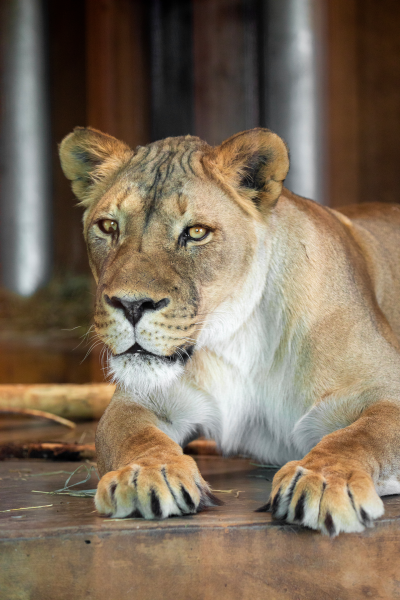

The Cheyenne Mountain Zoo family is mourning the loss of Zwena, a 13-year-old female African lion who was born at the Zoo. Monday afternoon, Zwena’s care team made the difficult and humane decision to euthanize her due to progressive neurological issues and her declining health and quality of life.

In July, we told you we were making adjustments for Zwena as she struggled with chronic mobility issues associated with her neurological condition. Between July and the beginning of October, she seemed to be having mostly good days. Despite continued treatment and care, she recently started declining quickly. The median life expectancy for African lions is 16.9 years, but as with humans and other species, life span can be less, due to various medical challenges, like the ones Zwena was facing.
Zwena, known affectionately as “Z” by her longtime keepers, was a staff favorite throughout the Zoo. She was well-loved and respected for her no-nonsense approach to building relationships with people.
“She was always the biggest personality out of the girls,” said Diana Miller, African Rift Valley keeper and Zwena’s primary trainer for nearly 9 years. “She was very loud. When she would see us coming she would either make a happy grumble or snarl at you. She was so sassy and fierce – and she loved to participate in her voluntary training. She was always enthusiastic with training and demonstrating her awesome lion behaviors during keeper talks. She would jump up on the cape buffalo statue with such vigor and a loud groan. She was impressive. She made a real impact with our guests.”
Zwena made an impact on her pride, too. She lived with Abuto, the pride patriarch; Lomela, her sister; and Elsa, her niece. The two younger males are Zwena’s nephews, Aslan and Boma. They lived with the full pride when they were younger, but now live as their own bachelor pride.
“The first time Z got to be with the cubs, Lomela was hesitant for them to go out into the big yard, but fearless Zwena just led them right out,” said Miller. “’Aunty Z’ encouraged all three cubs to chase her into the yard and the cubs went flying after her. She just loved playing with them. Lomela would lay nearby and call the cubs to come back, but they just wanted to go and play with Aunty Z. That was her vivacious personality in a nutshell.”
Zwena was an amazing ambassador for her species, helping guests fall in love with African lions through her energetic personality and intense focus. She will be dearly missed.
“She made me the keeper I am today,” said Miller. “You make connections with all of the animals you care for, but some animals leave a bigger paw print on your heart. Zwena definitely did that for me. I am so lucky to have gotten to know her and work with her. We will all miss her so much, but we’re grateful for the time we had together.”
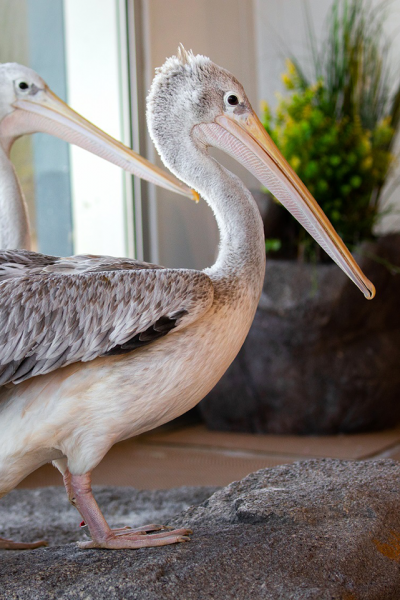

Three pink-backed pelicans joined the African penguins at Water’s Edge: Africa today! Pandora, Plato and Penelope have moved into the penguin building, where they will stay for a few days to settle in before beginning to explore the outdoor penguin areas, too.

Pink-backed pelicans have a wingspan of 7 to 9 feet, but they’re one of the smaller species of pelicans. They’re native to lakes, rivers and ponds throughout southern Africa. They are named for the pale pinkish hue on their backs that can be seen when they stretch out their wings.
The three pelicans lived with African penguins at their previous AZA-accredited zoo in Maryland, so they’re used to sharing space with them. Keepers say the penguins have been giving the pelicans space this afternoon and have responded well to their presence.
Pandora, a 4-year-old female, will live at CMZoo temporarily while her new exhibit and breeding partner prepare for her arrival at another AZA-accredited zoo. 4-year-old male, Plato, and 4-year-old female, Penelope, will live here for the foreseeable future as companions to each other and our penguin flock.
Their keepers say the three large birds are really curious and have been exploring the exhibit. Just like our flock of 17 African penguins, once the pelicans feel comfortable, they will have the opportunity to share sidewalks with guests on Boulder Beach, at Water’s Edge.
Next time you’re at the Zoo, swing by and say hello to our new pelican ambassadors.
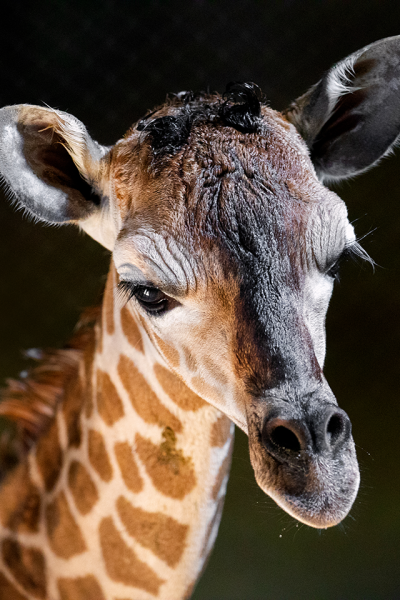

Bailey, an 8-year-old reticulated giraffe at Cheyenne Mountain Zoo, welcomed her very first calf to the herd at 11:37 a.m. today. Bailey and the female giraffe calf are doing well. Following Cheyenne Mountain Zoo tradition, the calf will be named after she is 30 days old.

“You couldn’t ask anything more of a first-time mom,” said Jason Bredahl, giraffe animal care manager at CMZoo. “Bailey is nonstop grooming her baby, paying attention and making sure the baby is in a good position to nurse. Mom is doing a great job.”
The little calf is doing well, too. She’s already winning the hearts of CMZoo staff and online fans.
“This is probably the smallest giraffe calf I’ve ever seen,” said Bredahl. “Bailey is small for a giraffe, too, so that’s not surprising. She’s super adorable. She’s strong and is nursing well, so we’re really excited to share her with everyone as soon as we can.”
At first, the calf had a hard time standing because she had positioned herself in a corner of the stall and she kept bumping into the walls before she could get her footing. After waiting to see if she could get up on her own, keepers and vet staff asked Bailey to move into another area so they could give the calf a hand. The team picked her up and moved her into the middle of the stall around 1:27 p.m. She took her first steps on her own after a quick medical assessment, then a nudge from mom, at 1:38 p.m. As long as keepers observe that baby and mom are doing well, they will continue to let Bailey take the lead on providing her care.
The weight and height of the calf are not known yet, although keepers and vet staff say she is one of the smallest giraffe calves they’ve ever seen. Newborn giraffe calves are typically five to six feet tall and weigh 150 to 200 pounds. Exact measurements haven’t been taken, but this calf appears to weigh about 100 pounds and is around five-and-a-half feet tall.
The calf is the seventeenth member of Cheyenne Mountain Zoo’s reticulated giraffe herd. The calf is the first offspring for mom, Bailey, and the sixth to be sired by dad, Khalid (pronounced cull-EED). Bailey moved to Cheyenne Mountain Zoo on a breeding recommendation in Sept. 2016. CMZoo’s breeding program began in 1954 and has welcomed more than 200 calves since its inception.

Thousands of worldwide viewers witnessed the calf’s birth on Cheyenne Mountain Zoo’s live camera feed, which will continue to stream live from the sand stall, where Bailey and the calf will continue to bond for the coming weeks. The live stream of the birth stall, and both outdoor giraffe yard camera feeds, are available at cmzoo.org/giraffecam. The Zoo will continue to provide updates on their social media channels.
The barn will remain closed to guests for at least another day, to give the new calf time to bond with mom. Other members of the CMZoo herd will be available for viewing and feeding in the outside yard from elevated platforms, where guests can get eye-to-eye with and feed lettuce to the herd, weather permitting.
Cheyenne Mountain Zoo is not only a leader in the training and health of giraffe in human care, but they are also making a huge difference in conservation of giraffe in the wild. Reticulated giraffe, the subspecies to which CMZoo’s herd belongs, are endangered. There are just over 11,000 mature reticulated giraffe individuals in the wild, and that population is decreasing. According to International Union for Conservation of Nature’s (IUCN) Red List of Threatened Species, the reticulated giraffe population has declined by 56% in the last thirty years.
In October and November 2019, CMZoo helped establish a new population of a critically endangered giraffe in Uganda. The Operation Twiga IV team successfully reintroduced 15 Nubian giraffe to Pian Upe Wildlife Reserve, where they haven’t existed in nearly 25 years. CMZoo VP of Mission and Programs, Dr. Liza Dadone, assisted with research and anesthesia, and provided care for the giraffe during the translocation. Our contribution to this effort is possible thanks to ongoing support from CMZoo members, guests and donors. Operation Twiga IV is led by Uganda Wildlife Authority with support from Giraffe Conservation Foundation, Colorado State University Veterinary Teaching Hospital, Cheyenne Mountain Zoo and other partners from around the world. See a video about the Zoo’s latest field conservation effort, Operation Twiga IV, here.
Through Cheyenne Mountain Zoo’s Quarters for Conservation program, by which 75 cents of every Zoo admission is allocated to conservation, guests have helped CMZoo send more than $3 million to support important conservation efforts since 2008.
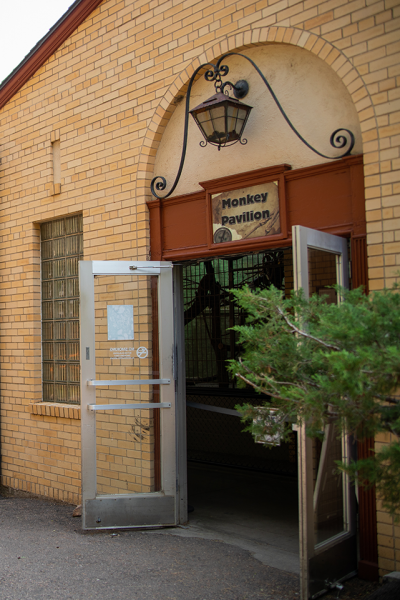

Cheyenne Mountain Zoo is moving forward with plans to demolish Monkey Pavilion, located centrally near the Zoo’s eateries and historic carousel, starting in November. Monkey Pavilion was built in 1942 and originally housed big cats, such as tigers, leopards and lions. Since then, the building has undergone renovations to support residents including lemurs, monkeys, sloths and more.
Since their inception, zoos have modernized in leaps and bounds. Fostering relationships between our guests and animals is our top priority, supported by our focuses on animal care, conservation and education. The animals’ homes play a vital role in our ability to achieve our goal of helping people fall in love with wildlife and wild places. We understand perception matters. We want to inspire our guests, and have seen that if an enclosure presents too many barriers, our ability to foster those connections is limited.
While the building provided good homes and enriching experiences for the animals that lived there, it falls short of providing an environment that helps our keepers build connections between guests and animals. We see opportunities for better use of the area. The possibilities seem endless, and we are considering every idea. We have not yet made decisions about the future of the space, but will announce them when the time is right.
The building, once considered architecturally beautiful and state-of-the-art, has become a symbol of zoos past, and its design does not reflect who we are today. We acknowledge that Monkey Pavilion is an iconic building at Cheyenne Mountain Zoo. Many longtime guests, members and staff have childhood photos by the outdoor exhibits or with the nearby zebra and lioness statues, which will be relocated within the Zoo. Its now-dated design is a nod to the progress Association of Zoos and Aquariums-accredited modern zoos have made since its construction, and its demolition is further evidence of the importance we place on providing the best possible opportunities for our guests to fall in love with animals, without distracting barriers.
Embracing our past, and learning from it, strengthens our future potential. It highlights how far we’ve come through positive changes across the zoo profession, and it encourages us to keep striving for additional change that will make us even better in the future.
Of course, demolishing this building requires a lot of coordination, and our animals’ best interests are at the heart of our planning, along with ensuring our guests’ experiences aren’t negatively impacted by the building’s removal. Some current Monkey Pavilion residents will move to other spaces at Cheyenne Mountain Zoo. For others, we have identified new homes at other AZA-accredited facilities. The building will continue to empty over the next month and a half, with the building closing October 28, 2020.
Demolition is slated to begin in November and is expected to take several months. We will keep you posted as we make progress on this historic update to our Zoo.
About Cheyenne Mountain Zoo
Cheyenne Mountain Zoological Society was founded in 1926. Today, Cheyenne Mountain Zoo, America’s mountain Zoo, offers comprehensive education programs, exciting conservation efforts and truly fantastic animal experiences. In 2020, Cheyenne Mountain Zoo was voted #4 Best Zoo in North America and CMZoo’s Rocky Mountain Wild was named #2 Best Zoo Exhibit in North America by USA TODAY 10Best Readers’ Choice Awards. It is Cheyenne Mountain Zoo’s goal to help guests fall in love with animals and nature, and take action to protect them. Of the 233 zoos and aquariums accredited by the Association of Zoos and Aquariums (AZA), Cheyenne Mountain Zoo is one of just a few operating without tax support. Cheyenne Mountain Zoo depends on admissions, membership dues, special event attendance and donations for funding.
Active duty and veteran military members receive 50% off admission for entire household – Cheyenne Mountain Zoo’s annual Military Appreciation Week is Monday, Sept. 14 through Sunday, Sept. 20, 2020. All active-duty, veteran and retired military members and their dependents who live in the same household will receive 50% off the base Zoo admission cost for the day and time they choose to attend. Timed-entry e-tickets are required and must be purchased in advance at cmzoo.org/military, due to COVID-19 restrictions.
Military Appreciation Week is the Zoo’s way of thanking military personnel for their service to our country. Tickets must be purchased in advance at cmzoo.org/military (capacity is limited); tickets will not be available for purchase at the Zoo’s admissions gates.
To validate their pre-purchased tickets at the front gate, military personnel and their dependents must present a valid military ID at Cheyenne Mountain Zoo’s admission booth. Accepted IDs include: a valid military / retired military ID; a copy of form DD214; state driver’s license printed with veteran indicator or military identifier; or ID issued by the VA, VFW or American Legion. If a service member is deployed, dependents are still entitled to this discount with a valid ID.
Fast Facts
Military Appreciation Week at Cheyenne Mountain Zoo
Monday, September 14 through Sunday, September 20
9 a.m. to 5 p.m. daily; guests must arrive within 20 minutes of their ticketed time
Active-duty, veteran or retired military and their immediate family in the same household
50% off base Zoo admission
For more information and to purchase required advance e-tickets, visit: www.cmzoo.org/military
Cheyenne Mountain Zoo’s Military Appreciation Week is possible because of the generous support of our partners, Black Bear Diner, Children’s Hospital Colorado, ENT Credit Union, and your Colorado Springs Toyota Dealers.
About Cheyenne Mountain Zoo
Cheyenne Mountain Zoological Society was founded in 1926. Today, Cheyenne Mountain Zoo, America’s mountain Zoo, offers comprehensive education programs, exciting conservation efforts and truly fantastic animal experiences. In 2020, Cheyenne Mountain Zoo was voted #4 Best Zoo in North America and CMZoo’s Rocky Mountain Wild was named #2 Best Zoo Exhibit in North America by USA TODAY 10Best Readers’ Choice Awards. It is Cheyenne Mountain Zoo’s goal to help guests fall in love with animals and nature, and take action to protect them. Of the 233 zoos and aquariums accredited by the Association of Zoos and Aquariums (AZA), Cheyenne Mountain Zoo is one of just a few operating without tax support. Cheyenne Mountain Zoo depends on admissions, membership dues, special event attendance and donations for funding.
